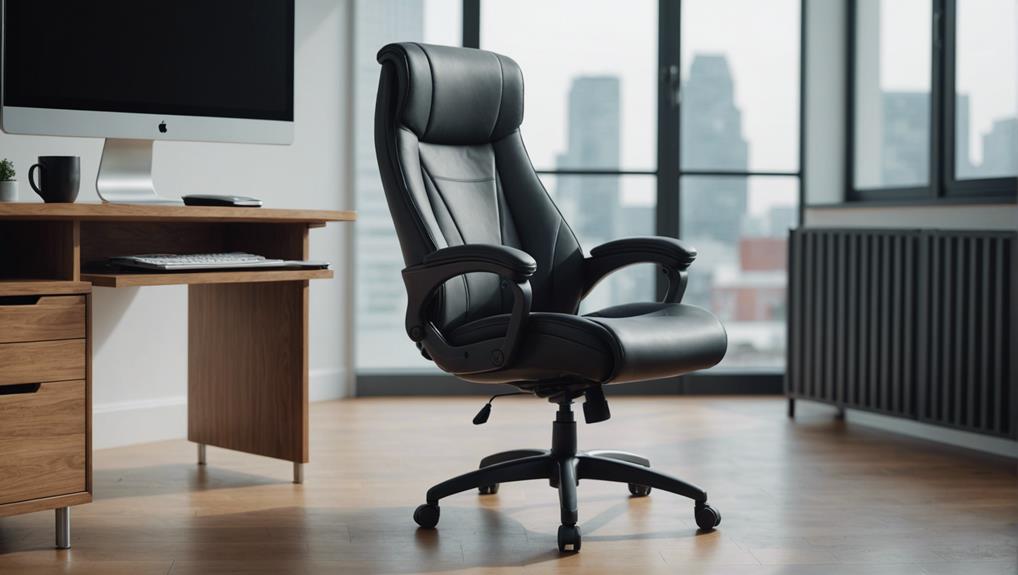Mastering chair design requires striking a balance between comfort and style. The evolution of basic wooden structures to upholstered seats and the influence of ancient civilizations on lounge chair prototypes are key parts of chair design history.
Various chair types, each with a unique purpose, offer endless possibilities for creating stylish and comfortable spaces. Understanding materials, ergonomics, and the role of chairs in interior design is crucial for creating inviting spaces.
Table of Contents
ToggleHistory of Chairs
The origin of chairs traces a historical path from basic wooden structures to upholstered seats, showcasing a progression in design and materials.
Initially, chairs were simple wooden pieces, evolving to incorporate upholstery for enhanced comfort and aesthetics. Wood, a durable and versatile material, allowed for intricate designs, while upholstery added layers of comfort with padded cushions and luxurious fabrics. This combination marked a significant shift in chair design, blending functionality with style.
The evolution of chairs highlights craftsmen’s ingenuity in creating pieces that serve as both seating solutions and symbols of artistry and cultural significance in furniture design.
Early use and development
The emergence of lounge chairs in history symbolized luxury and comfort, evolving into versatile pieces of modern furniture. Initially associated with opulence, lounge chairs prioritized a blend of comfort, functionality, and aesthetics. Over time, these chairs underwent design modifications to adapt to changing trends in furniture design, becoming essential in modern homes.
Lounge chairs are now ubiquitous in various settings like living rooms, bedrooms, home offices, and outdoor patios. Their adaptability allows them to complement different interior styles, catering to individual preferences. Whether for relaxing in a cozy corner of the living room or providing comfort in a home office or dining room, lounge chairs embody the perfect combination of style and functionality.
Evolution through different cultures and eras
Lounge chairs have evolved over history, shaped by various cultures and design trends. Ancient civilizations like the Egyptians, Greeks, and Romans influenced early lounge chair prototypes. Each era brought unique influences to lounge chair design, reflecting artistic, cultural, and functional needs.
From thrones to benches, lounge chairs have transformed across centuries. Cultural contexts and societal norms have heavily impacted their evolution, blending form, function, and cultural significance. The dynamic nature of design is showcased through the evolution of lounge chairs across different cultures and eras, responding to changing preferences and requirements.
This continuous adaptation highlights the enduring appeal of lounge chairs as essential furniture pieces throughout history.
Impact of industrialization on chair design
Industrialization revolutionized chair design by introducing mass production techniques and new materials like metal and plastic. This led to standardized parts, lower production costs, and increased manufacturing efficiency.
Chairs evolved with more uniform and streamlined designs, expanding creative possibilities. The aesthetic and functional aspects of chairs reflected the trends of modern design, making them more accessible to a broader audience.
Types of Chairs
Various types of chairs cater to different needs and styles. Armchairs feature comfortable armrests, ideal for relaxation in living rooms or bedrooms.
Side chairs, versatile options suitable for dining rooms, offices, or as accent pieces, typically lack armrests.
Lounge chairs prioritize comfort with ergonomic designs, creating cozy reading nooks or relaxation spaces.
Rocking chairs offer a soothing back-and-forth motion, ideal for unwinding.
Dining chairs are crafted for dining tables, coming in a range of styles from traditional to modern, enhancing the dining experience.
Each type serves a distinct purpose, blending functionality with style to meet diverse preferences and needs in furniture design.
Armchair
Armchairs are upholstered seats with armrests designed to provide support and comfort in various living spaces. They come in a range of styles, from classic wingback designs to contemporary swivel options, catering to diverse design preferences. Armchairs can serve as statement pieces in a room, adding elegance and functionality.
One key feature of armchairs is the variety of upholstery options available, including luxurious leather for a sophisticated look or durable fabrics for practicality. This customization allows for personalization to complement existing decor or create a focal point in the room.
Armchairs can be placed in settings such as living rooms, bedrooms, home offices, or reading nooks, enhancing comfort and style. Their combination of functionality and aesthetic appeal makes them a popular choice for homeowners looking to elevate their interior design.
Dining chair
Dining chairs are furniture designed for use at dining tables. They provide seating and enhance the dining experience. Available in traditional, modern, and contemporary styles, they come in wood, metal, plastic, and upholstery fabric materials.
Some chairs have armrests and padded seats for comfort. Considerations include durability, weight for mobility, and maintenance needs. Balancing style, comfort, and practicality is key for creating a welcoming dining space.
Rocking chair
Rocking chairs provide a comforting seating experience with a curved base that allows for a relaxing back-and-forth motion. The versatile chairs can be used indoors or outdoors, adding charm to any space. The gentle rocking motion promotes relaxation and can reduce stress and anxiety, making them ideal for unwinding after a long day.
Available in various styles, materials, and finishes, rocking chairs cater to different preferences and complement diverse decor styles. Whether a classic wooden rocker on the porch or a modern upholstered one in the nursery, there’s a rocking chair for every need.
Apart from being comfortable, rocking chairs offer a functional seating option that combines style with relaxation.
Recliner
Recliners have adjustable reclining mechanisms and supportive cushions for relaxation and comfort. They offer ergonomic contours for extended sitting comfort, crafted in materials like leather or fabric.
Recliners suit various interior styles and can be placed in living rooms, bedrooms, or home offices. Their versatility and emphasis on comfort make them a popular seating choice.
Office chair
Office chairs are designed to provide comfort and support for extended periods of work at desks. These chairs prioritize ergonomic features such as adjustable height, lumbar support, and armrests to enhance user comfort and prevent strain during long work hours. Office chairs come in various materials, including breathable mesh for ventilation and plush leather for a more executive look and feel.
Some office chairs have advanced functionalities like reclining mechanisms and swivel bases, offering users flexibility and adaptability in their workspace. Design considerations for office chairs include stability, mobility, and support for extended periods of use, ensuring users can maintain good posture and stay comfortable throughout their workday. Choosing the right office chair is essential for productivity and overall well-being in both home offices and corporate settings.
Accent chair
Accent chairs are versatile additions to any room, offering a range of shapes, sizes, and styles to suit various design themes. These chairs serve as statement pieces with bold patterns, vibrant colors, or unique textures, adding personality and flair to the space.
Additionally, accent chairs provide functionality by creating cozy seating areas in living rooms, bedrooms, or home offices, combining style and comfort seamlessly.
Lounge chair
Lounge chairs have a rich history spanning centuries, evolving to blend comfort, functionality, and aesthetics. They offer a luxurious seating option that enhances any space. These chairs come in various styles, from classic leather recliners to contemporary swivel chairs and popular mid-century modern designs, catering to diverse decor themes.
Their versatility allows placement in various settings like the living room, bedroom, home office, or outdoor patio, seamlessly adding elegance and comfort. Lounge chair design prioritizes comfort and ergonomics, with ergonomic contours, adjustable reclining mechanisms, and supportive cushions for optimal lumbar support. This focus on both aesthetics and functionality makes lounge chairs sought-after in stylish and comfortable seating arrangements.
Materials Used in Chair Construction
Chair construction utilizes wood, metal, and plastic materials to create diverse designs. Wood offers durability, versatility, and aesthetic appeal.
Metal frames provide a sleek and modern appearance with strength and stability.
Plastic chairs are lightweight, easy to clean, come in various colors and styles, and are suitable for indoor and outdoor settings.
Wood
Wood is a popular material in chair design due to its durability, warmth, and natural beauty. Oak, walnut, and maple are common wood species used, each offering unique grains and colors for diverse chair aesthetics.
Craftsmen employ traditional woodworking techniques like joinery and carving to create intricate details, showcasing their skill and artistry. Chairs are often finished with stains, paints, or natural oils to enhance appearance and protect the wood from wear.
Sustainability in design is emphasized through the use of reclaimed wood or certified lumber in chair construction, promoting environmental responsibility in the furniture industry. Wood’s versatility and timelessness make it a staple choice for stylish and enduring chairs.
Metal
Metal chairs, made from materials like aluminum, steel, or iron, are popular for outdoor use or in high-traffic areas due to their durability and modern aesthetic. Here are three key points about metal chairs:
- Versatile Design: Metal chairs showcase intricate designs or patterns, highlighting the versatility of metal in chair design. The range of design options varies from simple and elegant to ornate and detailed.
- Efficient Storage: Many metal chairs are lightweight and stackable, making them ideal for efficient storage and transportation in commercial settings. This feature is beneficial for venues that frequently rearrange seating arrangements.
- Customizable Colors: Metal chairs can be powder-coated in various colors, enabling customization to enhance visual appeal and match different decor styles. The extensive color options cater to a variety of preferences.
Plastic
Plastic chairs are a popular choice for modern lounge furniture due to their durability, affordability, and versatility. Plastic can be molded into various shapes and styles, allowing for a wide range of design options.
These chairs are lightweight, easy to move around, and suitable for outdoor use. They’re also easy to clean and maintain, making them ideal for high-traffic areas or households with children. The vibrant colors and unique finishes achievable with plastic add a contemporary touch to any space.
Whether you prefer a sleek and minimalist design or a bold and colorful statement piece, plastic chairs offer plenty of choices to suit your style. Plastic chairs are a practical and aesthetically appealing option for those looking to combine comfort, style, and affordability in their lounge furniture.
Upholstery materials
Upholstery materials for chairs offer a variety of options such as velvet, canvas, and leather, each with unique aesthetics and functionality. The fabric used in chair upholstery sets the stage for transformation, seamlessly integrating into the room’s overall aesthetic.
Skilled artisans employ meticulous craftsmanship in chair upholstery, reviving worn-out chairs into elegant pieces of art through precise pattern matching and stitching. Attention to detail in upholstery can elevate a simple chair into a true work of art.
Chair Design and Ergonomics
Ergonomic principles in chair design ensure maximum comfort and support for users. Chairs designed with ergonomics in mind promote good body posture, distribute pressure evenly, and accommodate natural movements while seated.
Key factors considered include seat height, depth, backrest angle, and armrest positioning to enhance ergonomic quality. Ergonomic chairs reduce strain on the body, improve productivity, and prevent musculoskeletal issues from prolonged sitting.
Manufacturers prioritize ergonomics to promote user well-being and satisfaction. These chairs not only offer comfort but also support the body effectively, contributing to overall health and comfort during extended sitting periods.
Importance of ergonomics in chair design
Ergonomics in chair design is crucial for user comfort and well-being. It ensures chairs support the body’s natural posture and movements. Three key aspects highlight its importance:
- Adjustable Seats: Chairs with ergonomic design offer adjustable components like height, depth, and angle. These adjustments customize the chair for specific needs, enhancing comfort and support.
- Lumbar Support: Ergonomic chairs include lumbar support to maintain the spine’s natural curve, reducing lower back pain and discomfort, and promoting better posture during prolonged sitting.
- Breathable Materials: Ergonomic chairs often use breathable materials, regulating temperature and moisture for a comfortable seating experience even during extended use.
Common ergonomic features
Adjustable height settings are crucial in chair design, allowing users to align their feet comfortably on the ground, promoting circulation and reducing leg pressure.
Lumbar support maintains the natural spine curve, reducing back strain, especially for prolonged sitters.
Well-designed armrests at the right height and angle decrease shoulder and neck tension.
Seat depth adjustment customizes thigh support and overall comfort.
Swivel and tilt mechanisms enhance flexibility and movement, reducing body strain during long periods of sitting.
These ergonomic features collectively ensure a comfortable and supportive seating experience.
Impact of poor chair design on health
Poor chair design can significantly impact health by causing musculoskeletal strain, discomfort, and limited adjustability. Chairs lacking proper support, such as inadequate lumbar support or poor cushioning, can lead to back pain, neck strain, and poor posture. These issues can worsen over time and affect daily activities.
Incorrect chair height and lack of padding can create pressure points on the body, causing discomfort and potentially leading to circulation problems. Prolonged sitting in such chairs may result in numbness or tingling sensations in the extremities.
Chairs with limited adjustability options fail to accommodate different body types and sitting preferences, compromising comfort and increasing the risk of developing musculoskeletal issues. Adjustability is essential for ensuring that a chair properly supports the user’s unique needs and promotes good posture.
The Role of Chairs in Interior Design
Chairs in interior design define areas within a room, complementing the design theme and offering comfort. They serve as focal points, reflecting personality and style, while enhancing functionality. By strategically placing chairs, different spaces can be created within a room, such as a cozy reading corner or a formal dining area. The choice of chairs significantly influences the mood, ambiance, and functionality of a space, shaping the overall look and creating a well-designed environment.
| Role of Chairs in Interior Design | Key Points | Impact |
|---|---|---|
| Define areas within a room | Enhance functionality | Create a well-designed environment |
| Complement design theme | Add aesthetic appeal | Influence mood and ambiance |
| Serve as focal points | Offer comfort and utility | Shape the overall look of a space |
| Reflect personality and style | Create cohesive design |
Choosing the right chair for a space
When selecting a chair for a space, consider these three key factors to ensure a seamless fit with the overall aesthetic:
- Functionality: Determine the chair’s primary use in the space—whether for lounging, dining, or working—to ensure comfort and practicality.
- Room Size: Assess the room’s dimensions to avoid overcrowding and maintain a balanced look with a chair that fits appropriately.
- Decor Style: Choose a chair that complements the room’s existing design scheme, be it modern, traditional, minimalist, or eclectic, to enhance the visual appeal.
Impact of chair style on room aesthetics
Chair style significantly impacts a room’s aesthetic. Modern designs with sleek lines offer a contemporary look, while traditional styles like wingback chairs add elegance.
Choosing chairs that align with the design theme creates a cohesive space. It’s essential to evaluate how chairs complement existing elements for a visually appealing room.
Color and material considerations
Color and material selections in chair design significantly impact the ambiance and aesthetic of the space. Here are three key considerations to keep in mind when designing chairs:
- Color Psychology: Colors evoke emotions and set the room’s tone. Warm tones like red and orange create a cozy atmosphere, while cool tones like blue and green promote calmness. Understanding color psychology helps in choosing the perfect hue for chair design.
- Material Selection: The material affects appearance, comfort, and durability of the chair. Velvet upholstery adds luxury, while canvas offers a casual feel. Leather is a timeless choice known for elegance and resilience, suitable for classic and modern designs.
- Combining Colors and Materials: Balancing color and material is crucial for enhancing chair design. Different color and material combinations can complement each other, creating a cohesive and visually appealing look.
Care and Maintenance of Chairs
Consistent maintenance practices are crucial for ensuring the longevity and appearance of chairs. Regular cleaning and dusting are necessary to maintain their overall look and durability. Using appropriate cleaning products based on the chair material helps prevent damage and preserves quality.
It’s important to periodically check for loose screws or wobbly legs to promptly tighten or repair them, ensuring stability and safety. Rotating cushions or pads helps evenly distribute wear, extending their lifespan and maintaining comfort levels.
Additionally, protecting chairs from direct sunlight, excessive moisture, and extreme temperatures is important in preventing cracks, discoloration, or warping. By following these maintenance tips, you can prolong the life of your chairs and maintain their optimal condition for an extended period.
Cleaning tips based on material
Maintain the appearance and longevity of your chairs by following these cleaning tips tailored to their specific materials:
- Leather Upholstery: Wipe with a damp cloth for routine cleaning. Apply a leather conditioner to keep the material soft and prevent cracking.
- Velvet Chairs: Vacuum using a soft brush attachment in the direction of the pile to remove dust and debris gently.
- Canvas Upholstery: Spot clean with mild soap and water to effectively tackle stains without damaging the fabric. Avoid harsh chemicals that may degrade its quality.
Regular maintenance practices
Regularly dusting and vacuuming upholstery is crucial to prevent dirt buildup and maintain the cleanliness of chairs. This practice helps extend the lifespan of chairs by keeping them fresh and inviting.
Checking and tightening loose screws and bolts is essential to ensure the stability and safety of chairs. Addressing any wobbliness promptly can prevent accidents and damage.
Additionally, lubricating moving parts like reclining mechanisms or swivel bases is vital to preserve the smooth functionality of chairs. This maintenance prevents squeaks and ensures a comfortable seating experience.
Inspecting chairs for signs of wear or damage allows for early intervention, preventing further deterioration and costly repairs.
Following the manufacturer’s guidelines for cleaning and care is important to maintain the quality appearance of chairs and ensure their longevity.
Repair and restoration
Repairing and restoring chairs involves a meticulous assessment of wear and tear to ensure longevity and functionality. Skilled artisans evaluate joints, upholstery, and wood surfaces to create a tailored restoration plan.
Replacement of worn-out parts like springs, cushions, and fabric is crucial for structural integrity and comfort. Aesthetic revival through refinishing wood, reupholstering with quality fabrics, and cohesive design elements enhances both functionality and style.
Future Trends in Chair Design
Future trends in chair design are shifting towards sustainability and innovative materials to reduce environmental impact. Designers prioritize eco-friendly materials and production methods to create aesthetically pleasing chairs that are gentle on the planet. Smart technology is revolutionizing chair functionality with adjustable seating positions and integrated charging ports becoming more common.
Modular and customizable chair designs are rising, allowing users to personalize their seating experience. This trend emphasizes versatility and adaptability in furniture design. Experimental shapes and forms, inspired by nature or futuristic concepts, are pushing the boundaries of traditional chair aesthetics, offering unique options for consumers.
Collaborations between designers and scientists/engineers are driving innovation in chair materials and construction techniques. This interdisciplinary approach aims to enhance comfort, durability, and sustainability in future chair designs, blending style and functionality harmoniously.
Sustainability in chair design
Sustainability is a pivotal aspect in chair design, emphasizing the use of eco-friendly materials, efficient production processes, and energy-saving practices.
In chair design, sustainability is achieved through the incorporation of reclaimed wood, recycled plastics, and organic fabrics to reduce environmental impact. Designers focus on minimizing waste by implementing efficient manufacturing methods and using recyclable components.
Energy-efficient practices are also integrated into the manufacturing and packaging processes to further decrease the environmental footprint.
Technological advancements
Chair design has evolved with the integration of cutting-edge technologies like carbon fiber and 3D printing. Designers use computer-aided design (CAD) software to create precise chair prototypes before production.
Automation, including robotic assembly and CNC machining, streamlines manufacturing processes. Smart features such as massage functions, heating elements, and adjustable settings enhance user comfort.
Virtual reality (VR) and augmented reality (AR) technologies simulate chair usage scenarios for design improvements. These advancements in chair design have raised comfort and functionality standards significantly.
Impact of remote work on chair design
Chair designers are prioritizing ergonomic features to support extended periods of sitting in response to the demands of remote work.
The focus on enhancing comfort and functionality has led to the incorporation of adjustable elements like lumbar support and reclining mechanisms.
Material innovation includes the use of breathable fabrics in chair upholstery to ensure comfort during prolonged sitting.
These changes in chair design aim to enhance the well-being and productivity of remote workers by creating a supportive environment in home offices.
Understanding the history, design variations, versatility, comfort, and materials of chairs is crucial for mastering the art of chair design.
Key elements like materials, craftsmanship, and design variations play a significant role in creating chairs that enhance aesthetics, offer ideal functionality, and cater to individual preferences.
Recap of key points
Lounge chairs have a rich history, evolving into essential comfort pieces in modern times. They offer a wide range of styles, including classic leather recliners, contemporary swivel chairs, and popular mid-century modern designs.
Versatility is a key feature of lounge chairs, as they can be placed in various settings such as living rooms, bedrooms, home offices, or outdoor spaces. Comfort and ergonomics take center stage in lounge chair design, with a focus on features like ergonomic contours and adjustable reclining mechanisms.
Different materials and finishes, ranging from luxurious leather upholstery to durable fabric choices, allow for customization to match personal style and complement different decors.
Final thoughts on the importance and evolution of chairs
Chairs have evolved from symbols of status and luxury to essential furniture pieces, adapting design and functionality over centuries. Today, chairs are crucial in interior design, enhancing spaces with style, comfort, and functionality. They reflect personal design preferences and serve as integral components of living environments.
As society changes, chairs will continue to meet modern living demands, blending practicality and artistic expression seamlessly.





